A Dialectical Synthesis of Fused Grid Theory and Fractal Islamic Urbanism: Addressing the Deficiencies of Street Grid and Hierarchy Systems in Riyadh City
Abstract
1. Introduction
- 1-
- What are the shortcomings of the Doxiadis gridiron and hierarchical street systems in Riyadh in relation to walkability, environmental impact, and cultural identity?
- 2-
- How can the fused grid theory be dialectically synthesized with the Islamic fractal geometry to compensate for these limitations?
- 3-
- What are the morphological responses of this synthesis, and how might they increase the level of urban sustainability in Riyadh?
- 1-
- The hybrid connectivity of fused grids combined with Islamic fractals can reduce the average path length from 15–20%, relative to the superblock system, and this will improve walkability and multi-modal permeability (in accordance with network analysis models in Boeing [3]).
- 2-
- Urban design inspired by fractal geometry will encourage environmental adjustments like a decrease of 2–3 °C in urban heat island effects through green and porous urban areas in the same direction as SDG 11 (adapted from Mohan et al. [4] and relevant literature).
- 3-
2. Literature Review
2.1. Thesis: Core Theories and Challenges
2.2. Antithesis: Different Paradigms Presented
| Layered quadrants advance adaptive responses to the various climate problems that challenge arid regions [19]. | ||
| Main Factors | Description | Potentials for Riyadh City |
| Quadrants and Hierarchies | 400 m × 400 m modules reduce disturbance, improve walkability. | Merge/existing grid systems. |
| Benefits: Safety, Health, Environment | Enhanced safety/lower pollution. | Safer, healthier, and better environment. |
| Applications and Features | Stratford/Calgary cases, T-junctions, pedestrian paths. | Safer, healthier, and better environment. |
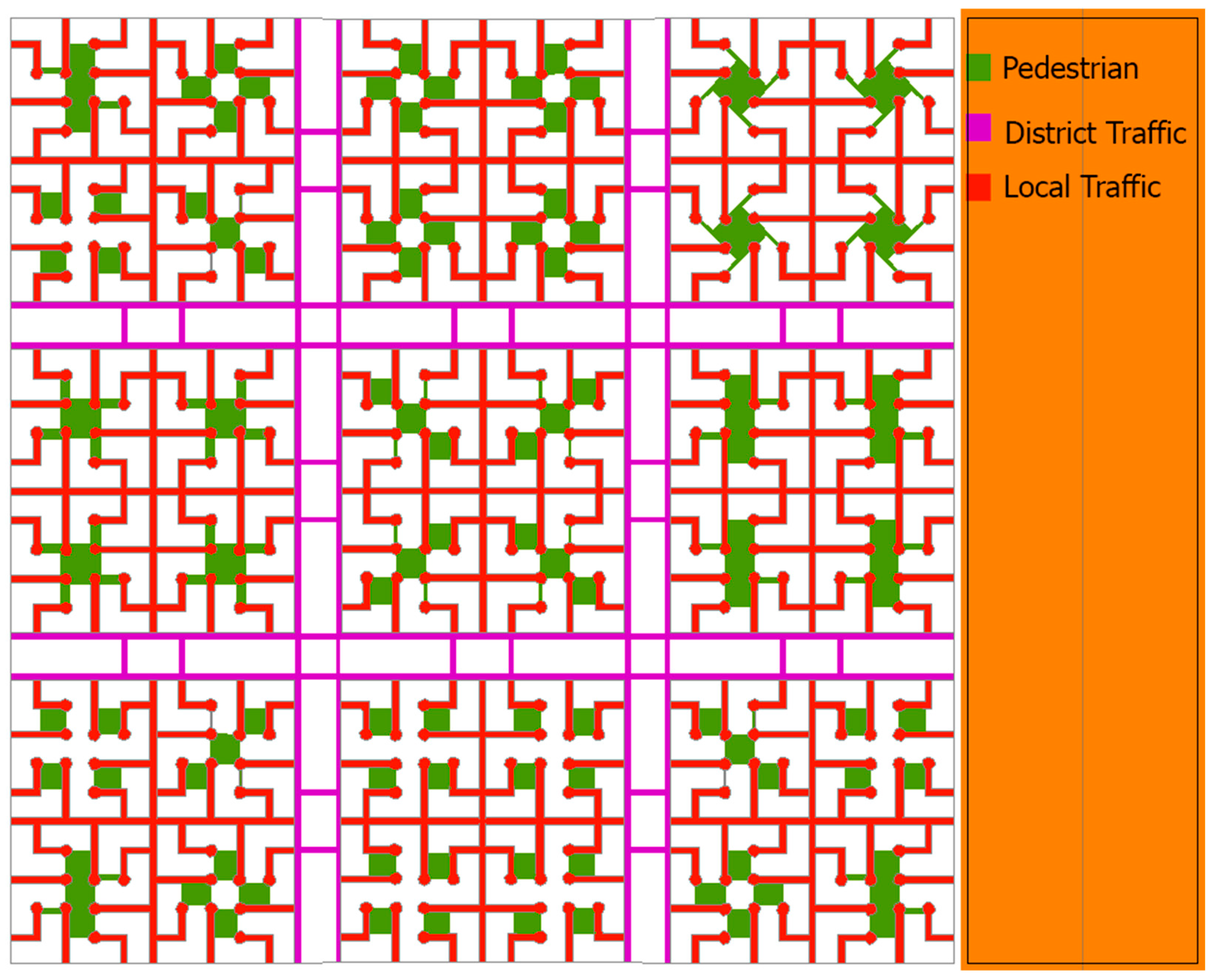
3. Method
4. Synthesis and Framework Construction
4.1. Synthesis
4.2. Framework Construction
5. Results
6. Discussion
7. Conclusions and Recommendations
Funding
Institutional Review Board Statement
Informed Consent Statement
Data Availability Statement
Acknowledgments
Conflicts of Interest
References
- UN-Habitat. Spatial Capital of Saudi Arabian Cities: Street Connectivity Study for the City Prosperity Initiative; Nairobi GPO KENYA: Nairobi, Kenya, 2015. [Google Scholar]
- Al-Mayouf, A.; Al-Khayyal, A. Provision of Public Housing in Saudi Arabia: Past, Current and Future Trends. J. King Saud Univ. 2011, 23, 59–68. [Google Scholar]
- Boeing, G. Methods and Measures for Analyzing Complex Street Networks and Urban Form. Ph.D. Thesis, University of Southern California, Berkeley, CA, USA, 2017. [Google Scholar] [CrossRef][Green Version]
- Mohan, D.; Bangdiwala, S.I.; Villaveces, A. Urban street structure and traffic safety. J. Saf. Res. 2017, 62, 63–71. [Google Scholar] [CrossRef] [PubMed]
- Stetsenko, A.; Arievitch, I. The Self in Cultural-Historical Activity Theory. Theory Psychol. 2004, 14, 475–503. [Google Scholar] [CrossRef]
- Alismail, A.A.A.; Alqahtany, A.; Alhamoudi, A.M.; Aljoaib, S.I.; Almazroua, S.M. Framework for Improvement of National Urban Strategy Model of Saudi Arabia by Logical Comparison with Best Practices in the World. J. Sustain. Res. 2025, 7, e250006. [Google Scholar] [CrossRef]
- Jarrar, O.M.; Al-Homoud, M. Sustainable urban development in Riyadh: A projected model for walkability. Int. J. Urban Sustain. Dev. 2024, 16, 398–421. [Google Scholar] [CrossRef]
- Yu, G.; Li, M.; Xu, L.; Tu, Z.; Yu, Q.; Yang, D.; Xie, X.; Yang, Y. A theoretical framework of urban systems and their evolution: The GUSE theory and its simulation test. Sustain. Cities Soc. 2018, 41, 792–801. [Google Scholar] [CrossRef]
- Alkhresheh, M. Urban Sprawl in Riyadh: Assessing the Impacts of Horizontal Expansion on Sustainability and Quality of Life. In Urban Innovation: To Boldly Go Where No Cities Have Gone Before. Medium Sized Cities and Towns as a Major Arena of Global Urbanisation. Proceedings of REAL CORP 2025, 30th International Conference on Urban Development, Regional Planning and Information Society, Graz, Austria, 14–16 April 2025; CORP–Competence Center of Urban and Regional Planning: Vienna, Austria, 2025; pp. 973–980. [Google Scholar]
- Alnaim, M. The hierarchical order of spaces in Arab traditional towns: The case of Najd, Saudi Arabia. World J. Eng. Technol. 2020, 8, 347–366. [Google Scholar] [CrossRef]
- Marshall, S. Building ON Buchanan: Evolving Road Hierarchy for Today’s Streets-Oriented Design Agenda. In Proceedings of the European Transport Conference, Strasbourg, France, 4–6 October 2004. [Google Scholar]
- Huang, J.; Cui, Y.; Chang, H.; Obracht-Prondzyńska, H.; Kamrowska-Zaluska, D.; Li, L. A city is not a tree: A multi-city study on street network and urban life. Landsc. Urban. Plan. 2022, 226, 104469. [Google Scholar] [CrossRef]
- Bandile, A. The Effect of Urbanization on Community Social Networks and Support Systems. Int. J. Humanit. Soc. Sci. 2024, 3, 46–59. [Google Scholar] [CrossRef]
- Sun, J.; Lovegrove, G. Comparing the road safety of neighbourhood development patterns: Traditional versus sustainable communities. Can. J. Civ. Eng. 2013, 40, 35–45. [Google Scholar] [CrossRef]
- Southworth, M.; Ben-Joseph, E. Street Standards and the Shaping of Suburbia. J. Am. Plan. Assoc. 1995, 61, 65–81. [Google Scholar] [CrossRef]
- Hillier, B.; Hanson, J. The Social Logic of Space; Cambridge University Press: Cambridge, UK, 1984. [Google Scholar] [CrossRef]
- Grammenos, F.; Craig, B.; POLLARD, D.; GUERRERA, C. Hippodamus Rides to Radburn: A New Model for the 21st Century. J. Urban. Des. 2008, 13, 163–176. [Google Scholar] [CrossRef]
- Grammenos, F.; Russell, R. Fused Grid Planning in a Canadian City; Zell/Lurie Real Estate Center, University of Pennsylvania: Philadelphia, PA, USA, 2007. [Google Scholar]
- Pinho, P.; Moretti, M.; Luz, A.C.; Grilo, F.; Vieira, J.; Luís, L.; Rosalino, L.M.; Martins-Loução, M.A.; Santos-Reis, M.; Correia, O.; et al. Biodiversity as Support for Ecosystem Services and Human Wellbeing. In The Urban Forest: Cultivating Green Infrastructure for People and the Environment; Pearlmutter, D., Calfapietra, C., Samson, R., O’Brien, L., Ostoić, S.K., Sanesi, G., del Amo, R.A., Eds.; Springer International Publishing: Cham, Switzerland, 2017; pp. 67–78. [Google Scholar] [CrossRef]
- Grammenos, F. The Fused Grid: An Urban Pattern for the Quality of Life. 2011. Available online: https://blog.fusedgrid.ca/wp-content/uploads/2011/01/QualityOfLife-McGill-2011-JanV2.pdf (accessed on 13 August 2025).
- Mohareb, N.; Kronenburg, R. ARAB WALLED CITIES: Investigating Peripheral Patterns in Historic Cairo, Damascus, Alexandria, and Tripoli; PUC: Santiago, Chile, 2012. [Google Scholar]
- Hakim, B.S. Arabic-Islamic Cities: Building and Planning Principles; EmergentCity Press: New York, NY, USA, 1986; Available online: https://books.google.com.sa/books?id=a1lQAAAAMAAJ (accessed on 13 August 2025).
- AlSayyad, N. Space in an Islamic City: Some Urban Design Patterns. J. Archit. Plan. Res. 1987, 4, 108–119. [Google Scholar]
- Mouratidis, K. Urban planning and quality of life: A review of pathways linking the built environment to subjective well-being. Cities 2021, 115, 103229. [Google Scholar] [CrossRef]
- Miri, G.; Sancholi, B.; Kadkhodaei, M.; Rad, S.S. An Examination of Iranian-Islamic City Model with Emphasis on Cultural Development in Zabol City. 2014. Available online: www.environmentaljournals.org (accessed on 13 August 2025).
- Schneider, C.A.; Rasband, W.S.; Eliceiri, K.W. NIH Image to ImageJ: 25 years of image analysis. Nat. Methods 2012, 9, 671–675. [Google Scholar] [CrossRef] [PubMed]
- Alqahtani, F.K.; Al-Jadhai, S.; Alromihy, H.; Alsaud, M.; Sherif, M.; Mohamed, A.G. Appraising critical success factors in sustainable housing projects: A comparative study of PPP modalities in Saudi Arabia. Heliyon 2024, 10, e32854. [Google Scholar] [CrossRef] [PubMed]
- Kutty, N.A.; Barakat, D.; Darsaleh, A.O.; Kim, Y.K. A Systematic Review of Climate Change Implications on Building Energy Consumption: Impacts and Adaptation Measures in Hot Urban Desert Climates. Buildings 2024, 14, 13. [Google Scholar] [CrossRef]
- Royal Commission for Riyadh City (n.d.). Urban Design Guide for Riyadh City—Public Transport Hubs: Metro Urban Design and Streetscape Manual. Available online: https://www.rcrc.gov.sa/en/publications/metro-urban-design-and-streetscape-manual/ (accessed on 13 August 2025).
- Masoud, A.R.; Idris, A.O.; Lovegrove, G. Modelling the impact of fused grid network design on mode choice behaviour. J. Transp. Health 2019, 15, 100627. [Google Scholar] [CrossRef]
- Patuano, A.; Lima, M.F. The fractal dimension of Islamic and Persian four-folding gardens. Humanit. Soc. Sci. Commun. 2021, 8, 86. [Google Scholar] [CrossRef]
- Moralı, G.; Topsakal, Y. A Comprehensive Analysis of Fractal Geometry in the Interior Architecture of the Astana Grand Mosque. Res. Multidiscip. Approaches 2025, 5, 67–76. [Google Scholar]
- Abdelsalam, M.; Ibrahim, M. Fractal Dimension of Islamic Architecture: The case of the Mameluke Madrasas: Al-Sultan Hassan Madrasa. Gazi Univ. J. Sci. 2019, 32, 27–37. [Google Scholar]
- Almoqaram, A. Fractal in Architecture Analytical Study to Traditional Houses in Baghdad. 2008. Available online: https://www.researchgate.net/publication/311983790_Fractal_In_Architecture_Analytical_study_to_traditional_houses_in_Baghdad_alksryt_fy_almart_drast_thlylyt_llbywth_altrathyt_fy_bghdad?channel=doi&linkId=5866cfcb08aebf17d39aeb39&showFulltext=true (accessed on 13 August 2025).
- Al-Kindy, S. The Effect of Spatial Organization on the Sustainability of the Neighborhood Unit in the Residential Environment. J. Eng. 2023, 18, 19–38. [Google Scholar] [CrossRef]
- Al-Homoud, M.; Jarrar, O. Walkability in Riyadh: A Comprehensive Assessment and Implications for Sustainable Community—Al-Falah Case Study. Sustainability 2024, 16, 8073. [Google Scholar] [CrossRef]
- Chenary, K.; Soltani, A.; Sharifi, A. Street network patterns for mitigating urban heat islands in arid climates. Int. J. Digit. Earth 2023, 16, 3145–3161. [Google Scholar] [CrossRef]
- Yasser, W.K. The architectural identity of Arab and Islamic cities. Int. J. Archit. 2018, 4, 1–10. [Google Scholar]
- Tsigdinos, S.; Nikitas, A.; Bakogiannis, E. Contextualizing urban road network hierarchy and its role for sustainable transport futures: A systematic literature review using bibliometric analysis and content analysis tools. Front. Eng. Manag. 2025, 12, 361–393. [Google Scholar] [CrossRef]
- Aina, Y.; Wafer, A.; Ahmed, F.; Alshuwaikhat, H. Top-down sustainable urban development? Urban governance transformation in Saudi Arabia. Cities 2019, 90, 272–281. [Google Scholar] [CrossRef]
- Abubakar, I.R.; Alshammari, M. Urban planning schemes for developing low-carbon cities in the Gulf Cooperation Council region. Habitat. Int. 2023, 138, 102881. [Google Scholar] [CrossRef]
- Alharthi, M.A.; Lenzholzer, S.; Cortesão, J. Climate responsive design in urban open spaces in hot arid climates: A systematic literature review. Discov. Cities 2025, 2, 38. [Google Scholar] [CrossRef]
- Al-Mosaind, M. Applying complete streets concept in Riyadh, Saudi Arabia: Opportunities and challenges. Urban. Plan. Transp. Res. 2018, 6, 129–147. [Google Scholar] [CrossRef][Green Version]
- Abdelfattah, D.; Nasreldin, R. Towards inclusive public open space in CBD case study of King Abdallah financial district. J. Urban Manag. 2025, in press. [Google Scholar] [CrossRef]
- Abdelfattah, D.; Taha, M.N.A.; Ashour, S.S.; Alkhresheh, M.; Alansary, S. Visionary Women’s Mobility Behavior a Tool for Women’s Inclusion in the Built Environment with Special Discourse on Riyadh City. Sustainability 2025, 17, 5584. [Google Scholar] [CrossRef]

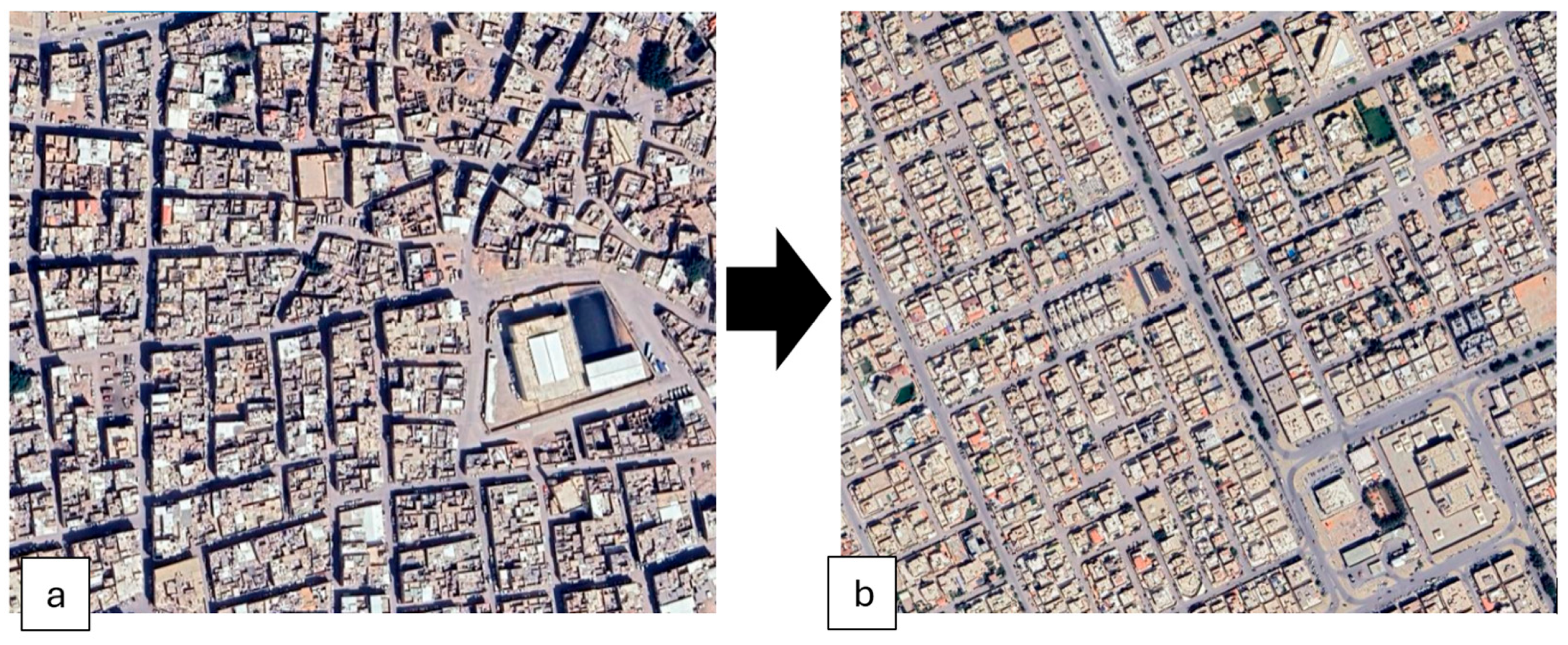


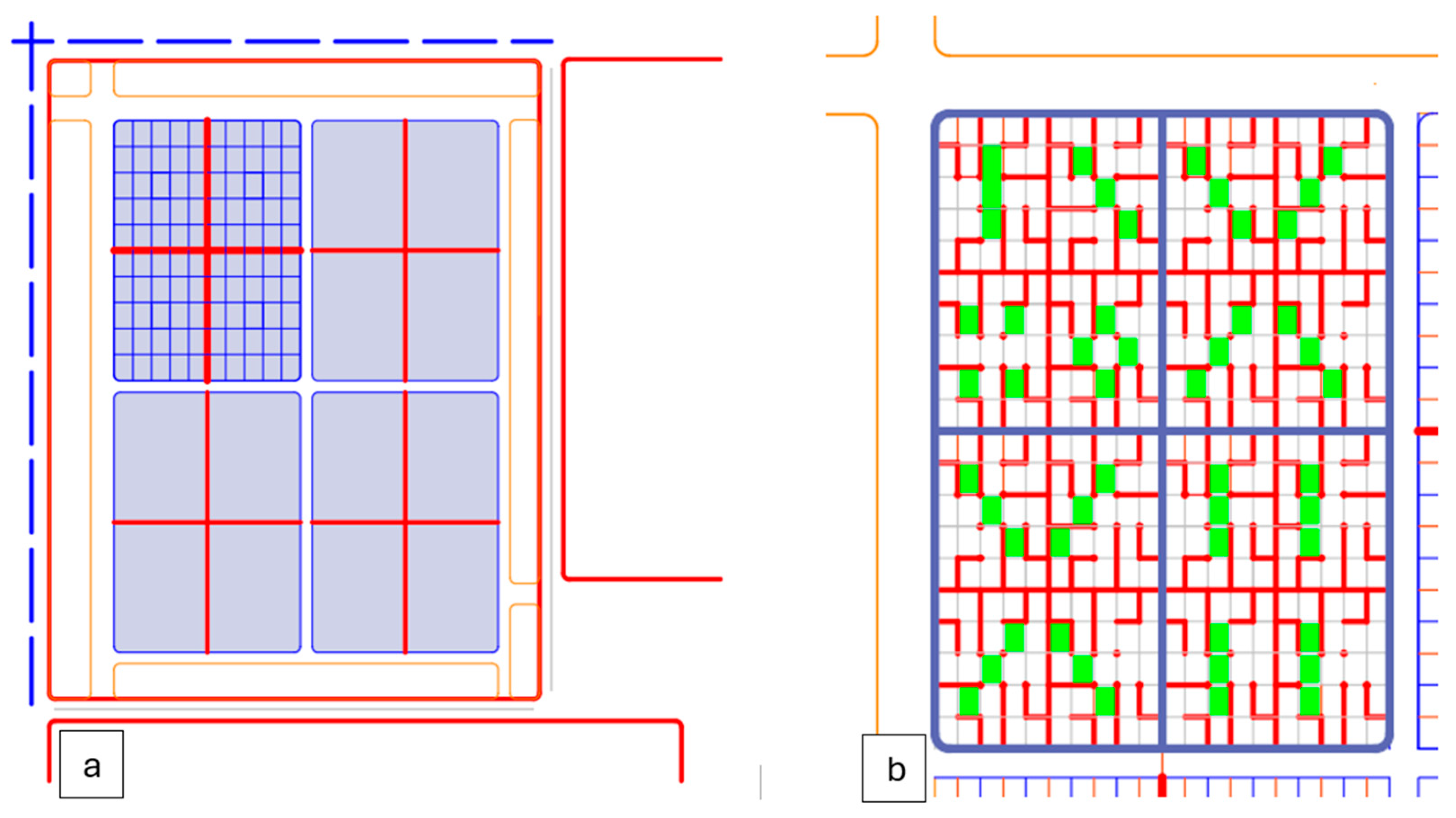

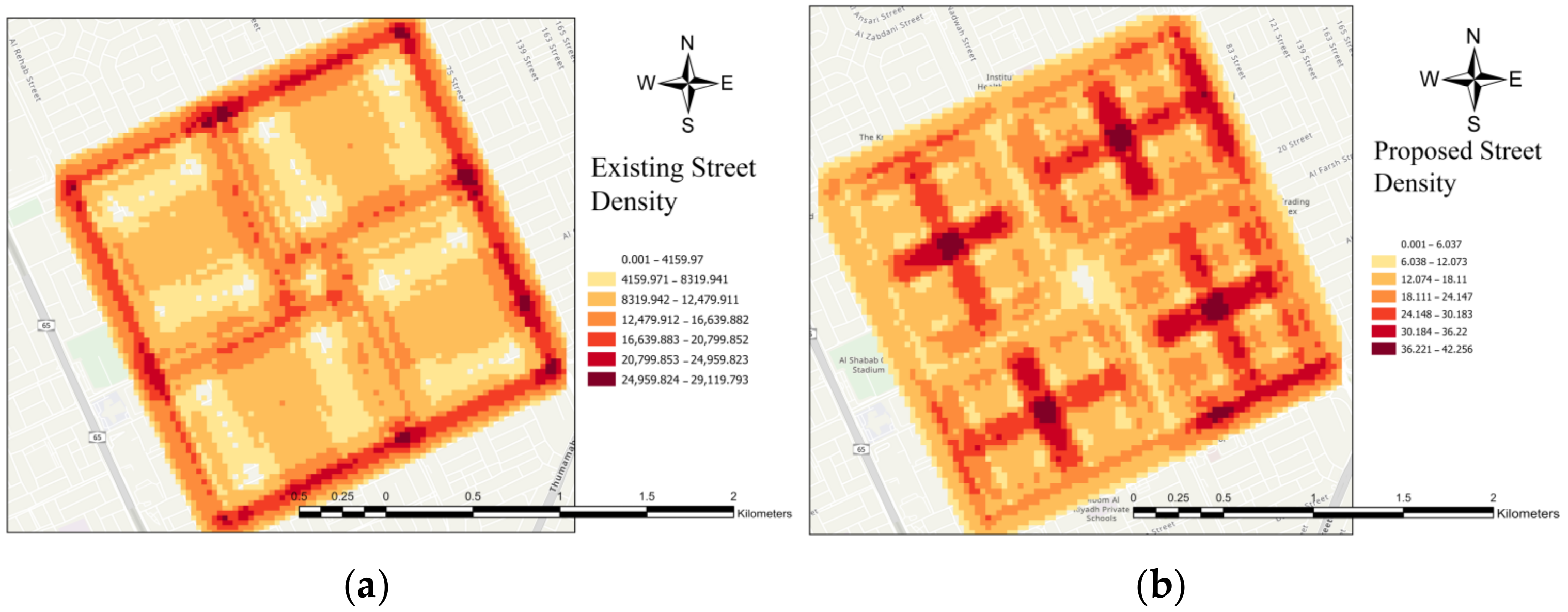
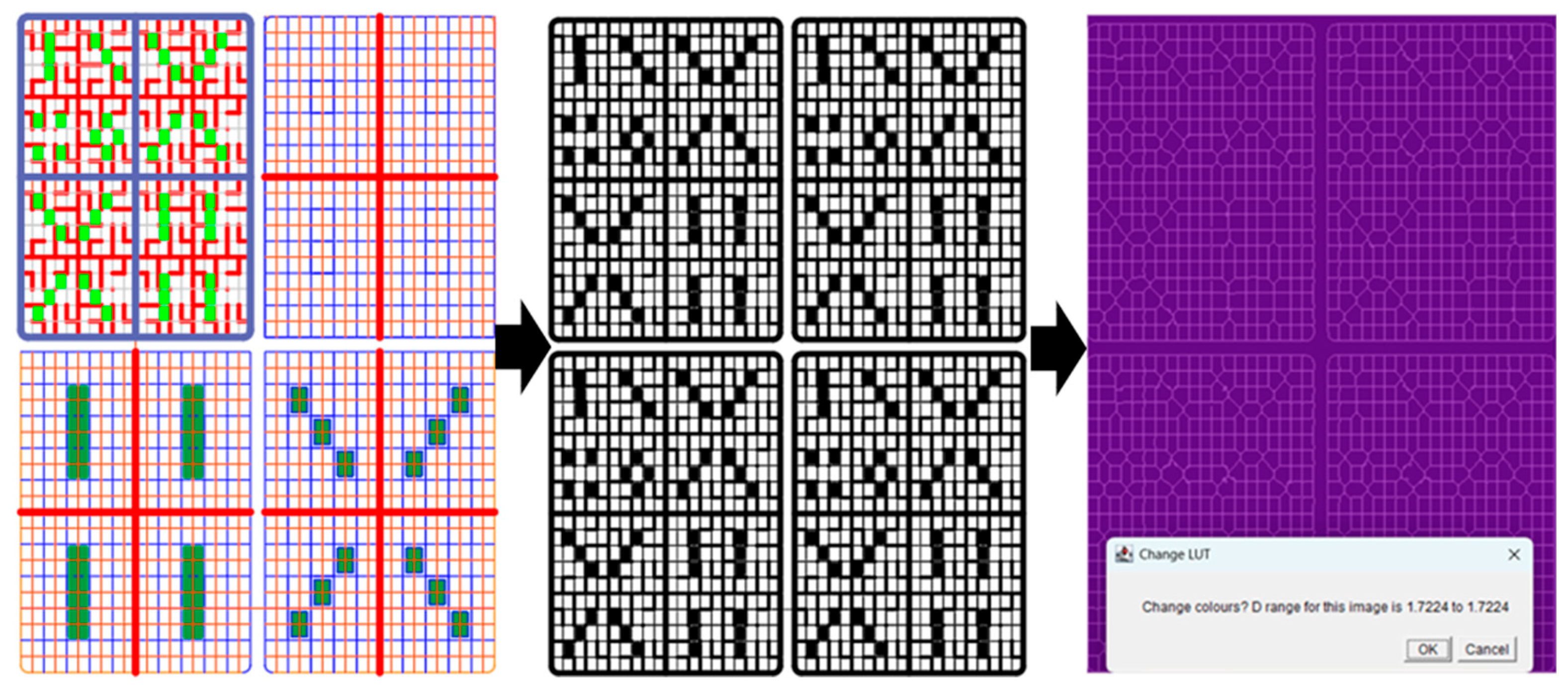
| Classification implies a binary view on these rival theories with regard to promoting emergent connectivity toward a resilient urban fabric, measured by network centrality indices [12]. | ||
| Category | Theory/Concept | Key Points |
| Opposing street grid and hierarchy | Christopher Alexander’s Theory: “A City Is Not a Tree” | Semilattice networks with overlap between subsystems. |
| Smart Growth | Supports compact, multi-use transit-oriented development to reduce sprawl and increase accessibility. | |
| Transit-Oriented Development (TOD) | Rejects car dependency; integrates density around public transit. | |
| Tactical Urbanism | Temporary, short-time lanes, enabling experimentation. | |
| General Critique | Exposes flaws in the hierarchies that create dependency and social alienation. | |
| Accepting frameworks operationalized hierarchy for improved movement dynamics with 10–15% gains in efficiency as calculated by traffic simulation models [11]. | ||
| Accepting street hierarchies | Systems Theory | Hierarchy with functional models for resource allocation and traffic management. |
| Contextual Road Network Grid and Hierarchy | Sustainable adjustment of hierarchies (also support regional needs). | |
| Phase Name | Core Concept | Key Outcome/Benefit | Focus | |
|---|---|---|---|---|
| 1 | Thesis: What are the core theories and challenges? | Hierarchical systems, car-oriented development | Establishes baseline, highlights sprawl issues | Problem mapping |
| 2 | Antithesis: Introducing contrasting paradigms | Critique of the ideas of separation and isolation | Exposes limitations, boosts walking levels | Contrasting paradigms |
| 3 | Synthesis: Resolution into an integrated typology composed of the fused grid with fractal morphology | Fused grid, Islamic fractal urbanism | Reduced greenhouse gas emissions, cultural fit | Integration |
| 4 | Framework construction | Pros: Greenhouse gases reduced, cultural fit layering modifications (dimensions, layouts) | Resilient diagram, quality of life | Actionable model |
| Theory | Vehicular Efficiency | Walkability | Cultural Fit | Environmental Sustainability | Social Interaction | Sprawl Control | Normalized Weighted Score (1–30) | Sensitivity Range (1–30) |
|---|---|---|---|---|---|---|---|---|
| Street Grid | 5 | 1 | 1 | 2 | 2 | 1 | 6.8 | 6.7–6.9 |
| Opposing Hierarchies | 2 | 5 | 3 | 4 | 5 | 5 | 21.4 | 21.2–21.6 |
| Fused Grid | 4 | 4 | 3 | 4 | 4 | 4 | 20.6 | 20.4–20.8 |
| Islamic Fractal | 3 | 4 | 5 | 5 | 5 | 4 | 25.5 | 25.3–25.7 |
| Hybrid | 4 | 5 | 5 | 5 | 5 | 5 | 28.9 | 27–31 |
| Level | Gross Dimensions | Net | Scale Factor | Area |
|---|---|---|---|---|
| Existing superblock | 2 km × 2 km | N/A | 1 | 4 sq. km |
| Existing quadrant | 1 km × 1 km | 900 m × 650 m | 0.5 | 0.585 sq. km |
| Existing residential lots | N/A | N/A | N/A | Avg. 330 sq. m |
| Proposed Subquadrant | 500 m × 500 m | 450 m × 325 m | 0.25 | 0.14625 sq. km |
| Proposed Local Quadrant | 250 m × 250 m | 225 m × 163 m | 0.125 | 0.036675 sq. km |
| Proposed Residential Lot | N/A | 22 m × 15.8 m | N/A | 347.6 sq. m |
| Dimensional Guidelines Satisfy Fused Grids (Grammenos, 2011 [20]). | ||
|---|---|---|
| Category | Element | Details |
| Dimensions and Street Layout | Quadrant L1 (existing) subtracting the peripherals’ area | 1100 m × 800 m, 900 m × 650 m |
| Subquadrant L2 (proposed) like fused grid (400 m × 400 m) | 450 m × 325 m | |
| Local quadrants (subsubquadrant) L3 (proposed) Residential plot | 220 m × 150.8 m, 22 m × 15.8 m | |
| Arterials (existing) | 60 m, medians | |
| Collectors (existing) | 40 m, with bike lanes | |
| Local streets | 20 m, with T-junctions, eliminate U-turns | |
| Block Size | A = 347.6 m2 | 220 m × 150.8 m |
| Landscape Elements | Landscape integrations | 15% green spaces, native plants for shade. Smaller spaces, hierarchy in size for different outdoor uses |
| Walkability and Accessibility | Walkways and open spaces | 100% non-vehicular paths |
| Embedded Identity | Fractal planning, fractal outdoor spaces | Fractal design, in addition to traditional architectural elements |
Disclaimer/Publisher’s Note: The statements, opinions and data contained in all publications are solely those of the individual author(s) and contributor(s) and not of MDPI and/or the editor(s). MDPI and/or the editor(s) disclaim responsibility for any injury to people or property resulting from any ideas, methods, instructions or products referred to in the content. |
© 2025 by the author. Licensee MDPI, Basel, Switzerland. This article is an open access article distributed under the terms and conditions of the Creative Commons Attribution (CC BY) license (https://creativecommons.org/licenses/by/4.0/).
Share and Cite
Alkhresheh, M. A Dialectical Synthesis of Fused Grid Theory and Fractal Islamic Urbanism: Addressing the Deficiencies of Street Grid and Hierarchy Systems in Riyadh City. Sustainability 2025, 17, 8549. https://doi.org/10.3390/su17198549
Alkhresheh M. A Dialectical Synthesis of Fused Grid Theory and Fractal Islamic Urbanism: Addressing the Deficiencies of Street Grid and Hierarchy Systems in Riyadh City. Sustainability. 2025; 17(19):8549. https://doi.org/10.3390/su17198549
Chicago/Turabian StyleAlkhresheh, Majdi. 2025. "A Dialectical Synthesis of Fused Grid Theory and Fractal Islamic Urbanism: Addressing the Deficiencies of Street Grid and Hierarchy Systems in Riyadh City" Sustainability 17, no. 19: 8549. https://doi.org/10.3390/su17198549
APA StyleAlkhresheh, M. (2025). A Dialectical Synthesis of Fused Grid Theory and Fractal Islamic Urbanism: Addressing the Deficiencies of Street Grid and Hierarchy Systems in Riyadh City. Sustainability, 17(19), 8549. https://doi.org/10.3390/su17198549






